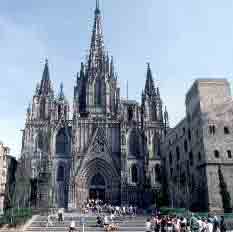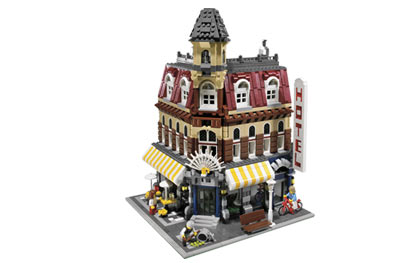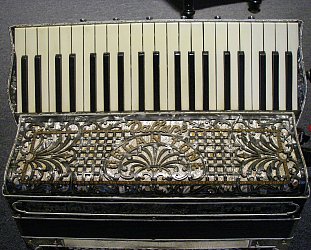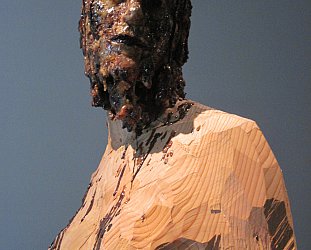Graham Reid | | 5 min read

Evening in Barcelona in a small cafe near the old Cathedral. I have spent the afternoon underground and now, over rich red wine and tapas, my thoughts have turned to the humble brick. Today I have touched these ancient building blocks. My back is resting against a wall which is perhaps a century old and so, seated by myself in an unfamiliar city, I am considering what I have seen this day.

The brick is a noble piece of work. It is architecture you can hold in your hand. Cities -- and civilisations -- have been built on them. But others may have fallen because of these simple objects.
Two thousand years before Christ in Mohenjo-daro, a lost city in what is now Pakistan, artisans made bricks from the local clay with ruthless efficiency. Unlike most previous civilisations which sun-dried their bricks -- a process best suited to the patient -- the builders of Mohenjo-daro used kiln-firing. And they made their bricks in the thousands simply by pressing wet clay into a brick-sized template box, slapping out the raw shape, and rolling them through the dust to put a fine dry coating over them. Then they fired them in huge kilns.
It was an effective and rapid process, and consequently Mohenjo-daro rose from the ordinary earth to become an urban civilisation of three-storey houses with indoor bathrooms connected to underground sewage systems. It was a sophisticated city we deserve to have seen.
But over time Mohenjo-daro was abandoned, buried in the dust of time, and was only rediscovered in the early 19th century. How could this cultured civilisation with its wells, a great public bath, broad staircases, and avenues have been lost so thoroughly to become a city of unknown memories?
Blame the brick.
Some archaeologists argue that because of the rapacious appetite of their kilns, these Indus people chopped down every tree in sight, pushing the forests back further and further from the city. Over the ages their depleted land became parched and arid as it fed those insatiable kilns. The hot winds blew pale brown river-dust into their streets and homes making their city intolerable. The solid streets and homes of brick were abandoned, disappearing beneath layer upon layer of choking dust.
It is an ecological warning from the past, that the humble brick may have been both the beginning and end of Mohenjo-daro.
As I am considering the dusty end to that civilisation there is a sudden downpour outside and through the café window I can see the brick walls of a building in the lane opposite lashed by the rain. The rivulets of water glisten, the wind blowing them into every crevice.
Bricks have been around for at least twelve thousand years, but it wasn't until 3500BC that firing became a common practice. With firing came permanence: bricks were more impervious to heat and water. In the deserts of Iraq southeast of Baghdad are the remains of Eridu which some claim to be the world's first city. It was made of mud bricks baked by the desert sun, and reed houses.
If it survives these troubled times then perhaps archaeologists in a more patient and peaceful age will learn from this text of the past, and that a civilised world will look again to the first principles of Mankind, the brick which built security and a home.
Bricks meant that houses -- homes even -- could be constructed to withstand the vagaries of weather, and meddlesome neighbours.
Anyone with a little physical effort and the most minimal of training can build with bricks. A suburban retaining wall or the structure of a house is literally within your grasp.
And we start toying with the idea of bricks when we are small. In a word, Lego.

Bricks are light and manageable -- well, individually at least -- and they have been the literal building block of civilisations, notably the Roman Empire. From Bath to Barcelona the brick was Rome's footprint across its expansionist empire, aqueducts like the towering three-storey Pont du Gard in Provence carrying the life-blood of civilisation, water, to cities and towns. Roman amphitheatres are monumental. How few of us can honestly say they have stood in Rome's Colosseum and been unimpressed by the size of the interlocking stones which support it 2000 years after its construction?
In Barcelona most visitors are rightly seduced by Gaudi's eccentric Sagrada Familia -- now being built of concrete bricks rather then the carved stone of Gaudi's original design -- but beneath the streets in the old part of the city are the blocks of more ancient builders.

Below the Cathedral and the adjacent Placa del Rei are layers of civilisations whose most visible remains are their bricks.
This is where I have spent my afternoon.
Down here eight centuries of ancient Barcelona, dating from the first century BC when it was the Roman city Barcino, are revealed. In this place are second century workshops where togas and simple skirts were washed, and the cloth dyed. A century later the place was much more smelly: it became a factory for salting fish and the open sewers can be seen. Wine was also produced here and the raw product from grapes in huge vats was flavoured by the addition of honey and sea salt.
Two centuries on and the Roman civilisation had been overlaid, literally, by Christianity. The stones of the bishop's residence and a 4th century baptistery are here. By the sixth century the site hosted a church.
And so it goes.
Ancient Barcino has been dusted off, much as Mohenjo-daro was, and it stands revealed for modern eyes. You can see the wheel ruts of wagons which passed this way 2000 years ago and left their mark in the compacted earth.
Over there are the dolia (large ceramic vessels) in the wine cellars. Over here the wash basins and frescoes from the early Gothic period. Through digital reconstruction on videos the visitor can tour the episcopal buildings of the 1600 years ago -- and then climb the stairs out of this buried history, stepping upward through the ages into a chapel built in the 14th century.
Outside on these same steps where tourists snap Instamatic cameras and point their digital downloads at the ancient bricks was where Columbus walked, back from his New World.

And what a homecoming he received as his parade came through these streets.
In 1493 Columbus arrived here from Seville with an exotic train of followers and trophies: half a dozen ``Indians'', many parrots, some trees and fruits from the place we now know as the West Indies.
Ferdinand and Isabel assembled their court to hear from the explorer in his own words.
He mounted the stone steps in the corner of the Placa del Rei in the old palace, where he had once been mocked for his belief that there was a fast passage to the distant east by heading west.
This time however he was invited to be seated before the king and queen, a gesture granted only to those of royal lineage. When he finished his extraordinary tale of hardship and adventure -- and restated his belief he had found the fast route to China and Japan, in addition to unimaginable quantities of gold -- the whole court accompanied him back to his lodgings.
He was the happy hero of the hour, and walked these very stones.
Today the narrow streets and lanes around the Cathedral funnel tourists and locals alike past busy shops and cafes like the one I am sitting in, small and warm within brick walls.
On days like this, when rain runs down massive walls turning them a shining black then gathers in puddles on the cobbled streets, it all has the look of permanence. But there -- and here, and everywhere -- we kid ourselves.
The evidence beneath our feet, deep down in the dark earth, is of civilisations rising and falling, layer upon layer.
Brick upon brick upon brick.
This first appeared in my travel book Postcards From Elsewhere, 2005
For further reading and information on Mohenjo-Daro: http://www.mohenjodaro.net/index.html







post a comment